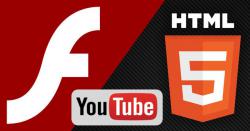YouTube to use HTML5 in place of Flash as default playback
Posted by: Jon Ben-Mayor on 01/28/2015 02:29 PM
[
 Comments
]
Comments
]
YouTube is beginning the transition to HTML5 for default playback; this transition effectively will out perform Flash and push it out the door. I can't say that I am sad about this evolution.
 YouTube posted the following on the company blog: Four years ago, we wrote about YouTube’s early support for the HTML5 < video > tag and how it performed compared to Flash. At the time, there were limitations that held it back from becoming our preferred platform for video delivery. Most critically, HTML5 lacked support for Adaptive Bitrate (ABR) that lets us show you more videos with less buffering.
YouTube posted the following on the company blog: Four years ago, we wrote about YouTube’s early support for the HTML5 < video > tag and how it performed compared to Flash. At the time, there were limitations that held it back from becoming our preferred platform for video delivery. Most critically, HTML5 lacked support for Adaptive Bitrate (ABR) that lets us show you more videos with less buffering.
Over the last four years, we’ve worked with browser vendors and the broader community to close those gaps, and now, YouTube uses HTML5 < video > by default in Chrome, IE 11, Safari 8 and in beta versions of Firefox.
The benefits of HTML5 extend beyond web browsers, and it's now also used in smart TVs and other streaming devices.
Given the progress we've made with HTML5 < video >, we’re now defaulting to the HTML5 player on the web. We're also deprecating the "old style" of Flash < object > embeds and our Flash API. We encourage all embedders to use the < iframe > API, which can intelligently use whichever technology the client supports.
These advancements have benefitted not just YouTube’s community, but the entire industry. Other content providers like Netflix and Vimeo, as well as companies like Microsoft and Apple have embraced HTML5 and been key contributors to its success. By providing an open standard platform, HTML5 has also enabled new classes of devices like Chromebooks and Chromecast. You can support HTML5 by using the < iframe > API everywhere you embed YouTube videos on the web.
 YouTube posted the following on the company blog: Four years ago, we wrote about YouTube’s early support for the HTML5 < video > tag and how it performed compared to Flash. At the time, there were limitations that held it back from becoming our preferred platform for video delivery. Most critically, HTML5 lacked support for Adaptive Bitrate (ABR) that lets us show you more videos with less buffering.
YouTube posted the following on the company blog: Four years ago, we wrote about YouTube’s early support for the HTML5 < video > tag and how it performed compared to Flash. At the time, there were limitations that held it back from becoming our preferred platform for video delivery. Most critically, HTML5 lacked support for Adaptive Bitrate (ABR) that lets us show you more videos with less buffering.Over the last four years, we’ve worked with browser vendors and the broader community to close those gaps, and now, YouTube uses HTML5 < video > by default in Chrome, IE 11, Safari 8 and in beta versions of Firefox.
The benefits of HTML5 extend beyond web browsers, and it's now also used in smart TVs and other streaming devices.
Given the progress we've made with HTML5 < video >, we’re now defaulting to the HTML5 player on the web. We're also deprecating the "old style" of Flash < object > embeds and our Flash API. We encourage all embedders to use the < iframe > API, which can intelligently use whichever technology the client supports.
These advancements have benefitted not just YouTube’s community, but the entire industry. Other content providers like Netflix and Vimeo, as well as companies like Microsoft and Apple have embraced HTML5 and been key contributors to its success. By providing an open standard platform, HTML5 has also enabled new classes of devices like Chromebooks and Chromecast. You can support HTML5 by using the < iframe > API everywhere you embed YouTube videos on the web.
Comments






